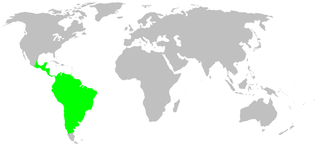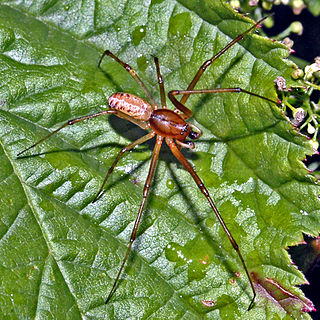
Wandering spiders (Ctenidae) are a family of spiders that includes the Brazilian wandering spiders. These spiders have a distinctive longitudinal groove on the top-rear of their oval carapace similar to those of the Amaurobiidae. They are highly defensive and venomous nocturnal hunters. Wandering spiders are known to hunt large prey, for example hylid species Dendropsophus branneri. Despite their notoriety for being dangerous, only a few members of Phoneutria have venom known to be hazardous to humans, but the venoms of this family are poorly known, so all larger ctenids should be treated with caution.

Theridion is a genus of tangle-web spiders with a worldwide distribution. Notable species are the Hawaiian happy face spider (T. grallator), named for the iconic symbol on its abdomen, and T. nigroannulatum, one of few spider species that lives in social groups, attacking prey en masse to overwhelm them as a team.

Wirada is a genus of comb-footed spiders that was first described by Eugen von Keyserling in 1886.

Thwaitesia is a genus of comb-footed spiders that was first described by Octavius Pickard-Cambridge in 1881.

Senoculus is a genus of araneomorph spiders in the family Senoculidae, and was first described by Władysław Taczanowski in 1872. It is the only genus in the family Senoculidae.

Cupiennius, known by the common name bromeliad spiders or as the often confused name banana spiders, is a genus of araneomorph spiders in the family Trechaleidae, named by Eugène Simon in 1891. They are found from Mexico to northwestern South America, and on some Caribbean islands. Unlike the dangerously venomous Phoneutria, bites from these spiders typically have only minor effects on humans, and have been compared to a bee sting.

Linyphia is a genus of dwarf spiders that was first described by Pierre André Latreille in 1804. The name is Greek, and means "thread-weaver" or "linen maker".

Ctenus is a genus of wandering spiders first described by Charles Athanase Walckenaer in 1805. It is widely distributed, from South America through Africa to East Asia. Little is known about the toxic potential of the genus Ctenus; however, Ctenus medius has been shown to share some toxic properties with Phoneutria nigriventer, such as proteolytic, hyaluronidase and phospholipase activities, in addition to producing hyperalgesia and edema. The venom of C. medius also interferes with the complement system in concentrations in which the venom of P. nigriventer is inactive, indicating that some species in the genus may have a medically significant venom. The venom of C. medius interferes with the complement component 3 (C3) of the complement system; it affects the central factor of the cascades of the complement, and interferes with the lytic activity of this system, which causes stronger activation and consumption of the complement components. Unlike C. medius, the venom of P. nigriventer does not interfere with lytic activity.

Dipoena is a genus of tangle-web spiders that was first described by Tamerlan Thorell in 1869.

Corinna is a genus of corinnid sac spiders first described by Carl Ludwig Koch in 1841. They are found in Mexico and south to Brazil, and with selected species found in Africa.
Viracucha is a genus of South American wandering spiders first described by Pekka T. Lehtinen in 1967.
Cyrtognatha is a genus of long-jawed orb-weavers that was first described by Eugen von Keyserling in 1881. It is a senior synonym of Agriognatha. Species of this genus are found in The Americas.
Sparianthina is a genus of huntsman spiders that was first described by Nathan Banks in 1929.
Exalbidion is a genus of comb-footed spiders that was first described by J. Wunderlich in 1995.

Thymoites is a genus of comb-footed spiders that was first described by Eugen von Keyserling in 1884.

Kiekie is a genus of wandering spiders first described by D. Polotow and Antônio Domingos Brescovit in 2018. The type species, Kiekie sinuatipes, was originally described under the name "Ctenus sinuatipes".
Bulboctenus is a genus of South American wandering spiders. It was first described by M. P. Pereira, F. M. Labarque and D. Polotow in 2020, and it has only been found in Brazil. As of November 2021 it contains only three species: B. itunaitata, B. kayapo, and B. munduruku.













